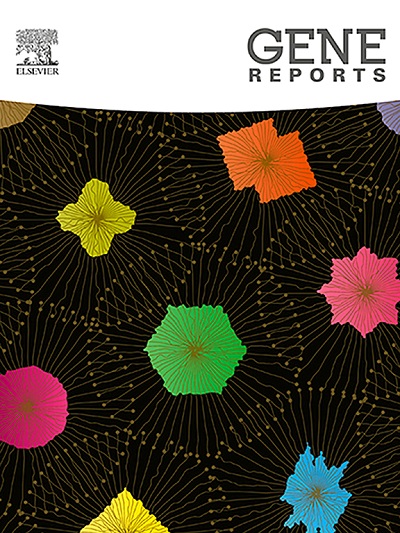与罕见的先天性赫尔曼斯基-普德拉克综合征9相关的BLOC1S6可能致病的同卵框移变体
IF 1
Q4 GENETICS & HEREDITY
引用次数: 0
摘要
赫尔曼斯基-普德拉克综合征(HPS)是一种常染色体隐性多系统疾病,根据涉及的基因分类,至少有 11 种不同类型。该病主要表现为酪氨酸酶阳性的眼皮肤白化病(OCA)、血小板储存缺乏症、血小板致密体缺失和免疫缺陷。本文描述了一名 2 个月大的女婴,她全身肌张力低下、反复感染、双侧视神经萎缩、眼球震颤、脑萎缩和肝酶升高。与父母不同,她有栗色的头发、白皙的皮肤和棕色的眼睛。她的父母是近亲结婚,他们的第一个孩子在5个月大时因类似症状夭折。对从患者外周血中提取的 DNA 进行了全外显子组测序(WES)。经过生物信息学分析,萨德拉医学遗传实验室在 BLOC1S6 基因的第五外显子上发现了一个可能致病的新型变异体(NM_001311255: c.506dupT: p. L169Ffs*33)。通过桑格测序,该变异在患者体内得到证实,并在患者父母中得到分离。该报告介绍了全球首例可能导致新生儿早期死亡的先天性 HPS-9 病例。我们的患者显示出了与 BLOC1S6 基因变异和 HPS-9 相关的新的重要特征,这对未来的研究、预测、临床管理、遗传咨询和产前诊断具有重要价值。本文章由计算机程序翻译,如有差异,请以英文原文为准。
A likely pathogenic homozygous frameshift variant in BLOC1S6 associated with a rare form of congenital Hermansky-Pudlak syndrome 9
Hermansky-Pudlak syndrome (HPS) is a collection of autosomal recessive multisystemic disorders with at least 11 different types, categorized on the basis of involved genes. The disease is mostly characterized by tyrosinase-positive oculocutaneous albinism (OCA), platelet storage deficiency, absence of platelet dense bodies, and immune deficiency. Here we described a 2-month-old female infant with generalized hypotonia, recurrent infections, bilateral optic atrophy, nystagmus, cerebral atrophy, and elevated liver enzymes. Unlike her parents, she had chestnut colored hair, fair skin, and brown eyes. Parents had a consanguineous marriage, and their first child had died with similar symptoms at the age of 5 months. Whole exome sequencing (WES) was performed on DNA extracted from the patient's peripheral blood. Following the bioinformatics analysis, a likely pathogenic novel variant in the fifth exon of the BLOC1S6 gene (NM_001311255: c.506dupT: p. L169Ffs*33) was introduced by the Sadra Medical Genetic Laboratory. This variant was confirmed in the patient and segregated in both parents by Sanger sequencing.
This report presented the first congenital case of HPS-9 worldwide that might have led to early neonatal death. Our current patient shows new considerable features related to the BLOC1S6 gene variant and HPS-9, which is a valuable source for future research, prediction, clinical management, genetic counseling, and prenatal diagnosing.
求助全文
通过发布文献求助,成功后即可免费获取论文全文。
去求助
来源期刊

Gene Reports
Biochemistry, Genetics and Molecular Biology-Genetics
CiteScore
3.30
自引率
7.70%
发文量
246
审稿时长
49 days
期刊介绍:
Gene Reports publishes papers that focus on the regulation, expression, function and evolution of genes in all biological contexts, including all prokaryotic and eukaryotic organisms, as well as viruses. Gene Reports strives to be a very diverse journal and topics in all fields will be considered for publication. Although not limited to the following, some general topics include: DNA Organization, Replication & Evolution -Focus on genomic DNA (chromosomal organization, comparative genomics, DNA replication, DNA repair, mobile DNA, mitochondrial DNA, chloroplast DNA). Expression & Function - Focus on functional RNAs (microRNAs, tRNAs, rRNAs, mRNA splicing, alternative polyadenylation) Regulation - Focus on processes that mediate gene-read out (epigenetics, chromatin, histone code, transcription, translation, protein degradation). Cell Signaling - Focus on mechanisms that control information flow into the nucleus to control gene expression (kinase and phosphatase pathways controlled by extra-cellular ligands, Wnt, Notch, TGFbeta/BMPs, FGFs, IGFs etc.) Profiling of gene expression and genetic variation - Focus on high throughput approaches (e.g., DeepSeq, ChIP-Seq, Affymetrix microarrays, proteomics) that define gene regulatory circuitry, molecular pathways and protein/protein networks. Genetics - Focus on development in model organisms (e.g., mouse, frog, fruit fly, worm), human genetic variation, population genetics, as well as agricultural and veterinary genetics. Molecular Pathology & Regenerative Medicine - Focus on the deregulation of molecular processes in human diseases and mechanisms supporting regeneration of tissues through pluripotent or multipotent stem cells.
 求助内容:
求助内容: 应助结果提醒方式:
应助结果提醒方式:


